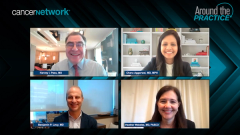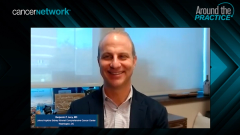
Biomarker Testing Practices in Non-Small Cell Lung Cancer
Comprehensive discussion on how biomarker testing and multidisciplinary care can improve the management of non–small cell lung cancer.
Episodes in this series

Transcript:
Charu Aggarwal, MD, MPH: Welcome to this CancerNetwork® presentation on adjuvant therapy in non–small cell lung cancer. I’m your host, Dr Charu Aggarwal. I’m the Leslye Heisler associate professor for lung cancer excellence at the University of Pennsylvania’s Abramson Cancer Center. I’m thrilled to be joined here with expert colleagues in the field of management of non–small cell lung cancer. I would like them to introduce themselves. I’ll start with Dr Benjamin Levy.
Benjamin P. Levy, MD: Hi, thank you, Charu Aggarwal. It’s a pleasure to be here. Dr Benjamin Levy. I’m an associate professor at Johns Hopkins School of Medicine and the clinical director for the Johns Hopkins Sidney Kimmel Cancer Center at Sibley Memorial Hospital.
Charu Aggarwal, MD, MPH: Welcome, and I will move on to Dr Heather Wakelee. Welcome.
Heather Wakelee, MD, FASCO: Thanks, I’m excited to be here today. I’m Dr Heather Wakelee. I’m a professor and chief of the division of medical oncology at Stanford University and the deputy director of the Stanford Cancer Institute.
Charu Aggarwal, MD, MPH:Welcome, Heather. Finally, to round us off in this multidisciplinary panel, welcome Dr Harvey Pass.
Harvey I. Pass, MD: Thanks Charu. I’m Harvey Pass. I’m the Stephen E. Banner professor of thoracic oncology for NYU [New York University] Langone Health and the vice-chair for research for the department of cardiothoracic surgery. It’s great to be here.
Charu Aggarwal, MD, MPH:Thank you. Today we’ll discuss therapy for non–small cell lung cancer. We’ll have an interactive discussion on 2 patient cases, and discuss new and emerging data as they relate to the management of both early stage as well as metastatic non–small cell lung cancer. I’d like to begin by asking our panelists about your approach to biomarker testing at your institution for patients with non–small cell lung cancer. Heather, we’ll start with you. What is your general practice and what is your pathway?
Heather Wakelee, MD, FASCO: Thanks. When a patient presents with newly diagnosed disease, our solid tumor testing is our in-house version of CAPP-Seq [Cancer Personalized Profiling by Deep Sequencing], which was developed by Max Diehn [MD, PhD,] and Ash Alizadeh [MD, PhD]. We’ll do that. To get faster answers though, we still do PCR [polymerase chain reaction] assays for EGFR and FISH [fluorescence in situ hybridization] for ALK and ROS [gene mutations]. We do have a high percentage of patients who have driver mutations, so that’s critical. We also realize that the tissue testing takes time, so we do liquid biopsies as well. We don’t yet have the CLIA [Clinical Laboratory Improvement Amendments] for our in-house test, so we tend to send it out. We alternate as to where we send to, but usually to Foundation [Medicine] or Guardant. Then for our patients with early stage disease, we tend to do reflex testing as well. Obviously, we’re not going to wait a couple of weeks to get the tissue testing back to make a perioperative decision in the preoperative setting. If it’s someone for whom we’re debating whether we’re going to do anything neoadjuvant, we’ll try to get the rapid test back before we make a decision, if it’s someone we think has a high probability. But most of our testing is still the tissue testing for the patients with early stage disease on the resected specimens.
Charu Aggarwal, MD, MPH: Could you talk a little about PD-L1 testing? Is it done as part of reflex testing?
Heather Wakelee, MD, FASCO: Yes. We do reflex PD-L1 testing on all of our non–small cell cancer patient samples, including the early stage patients.
Charu Aggarwal, MD, MPH:That’s great. Ben, could you talk about your practice, how different or similar might that be?
Benjamin P. Levy, MD: I think it’s pretty similar to what Heather mentioned. For our patients with advanced stage nonsquamous non–small cell lung cancer, we try to do both tissue NGS [next-generation sequencing] and a liquid biopsy or plasma genotyping. As you know, Charu, this comes a lot from your data, we know we miss some alterations in tissue that we can detect with ctDNA [circulating tumor DNA], and can better capture alterations and make an informed treatment decision. Our panel is a 3-fold panel. Obviously, we do PD-L1, we do a fusion panel, and we do a roughly 300- to 500-gene NGS assay. We’re missing those rapid tests that Heather talked about. We think those are becoming more and more important, not only in the advanced stage setting but also in the early stage setting when we’re entertaining neoadjuvant and adjuvant [treatment], which I’m sure we’ll talk about.
In the early stage setting, clearly, there are data now that we need this testing as well. We’ll talk about some of that data, but we try to do NGS on all of our patients with resected nonsquamous non–small cell lung cancer, independent of stage. The goal is reflexive testing for both advanced stage and early stage. I would say we’ve had some challenges with that because, at our institution at least, the pathologist can no longer be the ordering physician. We have had to come together as a group in a multidisciplinary team to talk about how we can get this test ordered at the time of tissue procurement, either by the interventional radiologist, the interventional pulmonologist, or the surgeon, so that we can have that testing done by the time the patient arrives at the medical oncology office.
Charu Aggarwal, MD, MPH: In addition, isn’t there a 14-day rule where we can’t technically order separate testing on a resected specimen within 14 days of surgery? That rule may be going away, but I agree there are definitely challenges there. Harvey, when you see patients with early stage lung cancer, how are you navigating referrals to medical oncology, multidisciplinary discussion, as well as this issue of testing?
Harvey I. Pass, MD: We like to present all the new lung cancers if possible at a multidisciplinary clinic, which is every Friday at 7 o’clock. When a patient comes to me who I think I’m going to be able to operate on, then certainly I know that my pathologists are going to do a first-order panel when the specimen comes out. Believe it or not, it’s an immunohistochemical panel in which we look at EGFR, ALK, and we also do PD-L1. We don’t do reflex NGS on those patients. For patients who have later-stage disease, certainly, after referral to the medical oncologist, they either use liquid or tissue, and we have our own in-house, now FDA-approved 607-gene panel that we use. It’s still a little time consuming to get that done, but if necessary, the medical oncologist also make well use of liquid biopsy as well as Foundation.
Charu Aggarwal, MD, MPH:That’s great. I think the process is very similar, at least in the advanced stage setting at our institution. We have an in-house solid tumor sequencing panel, which is reflex. Actually, Ben, to your point, we have our interventionalists “check off a box” in the electronic medical record. That serves as an order for molecular testing, which is performed in a reflex manner at the time of initial diagnosis of a nonsquamous histology. PD-L1 testing is done for all lung cancers. Then at the time of the initial visit, we are ordering usually plasma testing to expedite turnaround time and also to capture those patients who may have QNS [quantity not sufficient]. I love the idea that Heather has of these early tests for resectable patients and Harvey’s idea of presenting all of these in the multidisciplinary setting. We don’t have the capability to perform these rapid tests. In some ways we are going back to our single-gene testing, which we’ve largely moved away from. But I do think that it has certain advantages in the early stage setting.
Transcript edited for clarity.
Newsletter
Stay up to date on recent advances in the multidisciplinary approach to cancer.























































































